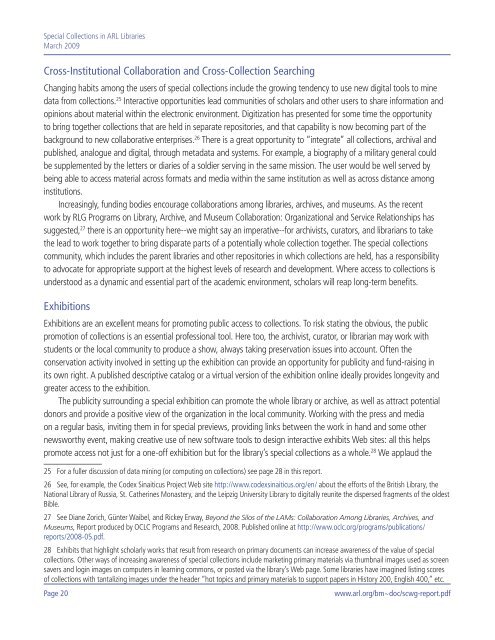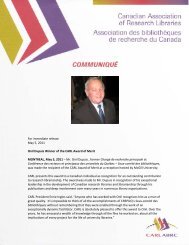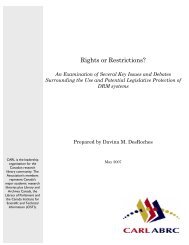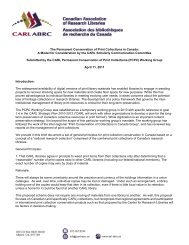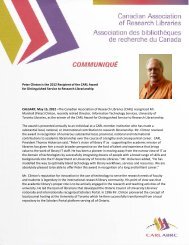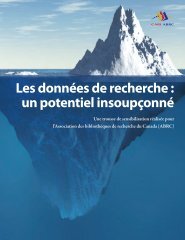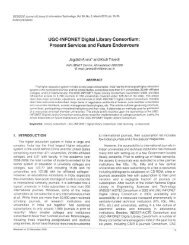PDF - CARL - ABRC
PDF - CARL - ABRC
PDF - CARL - ABRC
You also want an ePaper? Increase the reach of your titles
YUMPU automatically turns print PDFs into web optimized ePapers that Google loves.
Special Collections in ARL Libraries<br />
March 2009<br />
Cross-Institutional Collaboration and Cross-Collection Searching<br />
Changing habits among the users of special collections include the growing tendency to use new digital tools to mine<br />
data from collections. 25 Interactive opportunities lead communities of scholars and other users to share information and<br />
opinions about material within the electronic environment. Digitization has presented for some time the opportunity<br />
to bring together collections that are held in separate repositories, and that capability is now becoming part of the<br />
background to new collaborative enterprises. 26 There is a great opportunity to “integrate” all collections, archival and<br />
published, analogue and digital, through metadata and systems. For example, a biography of a military general could<br />
be supplemented by the letters or diaries of a soldier serving in the same mission. The user would be well served by<br />
being able to access material across formats and media within the same institution as well as across distance among<br />
institutions.<br />
Increasingly, funding bodies encourage collaborations among libraries, archives, and museums. As the recent<br />
work by RLG Programs on Library, Archive, and Museum Collaboration: Organizational and Service Relationships has<br />
suggested, 27 there is an opportunity here--we might say an imperative--for archivists, curators, and librarians to take<br />
the lead to work together to bring disparate parts of a potentially whole collection together. The special collections<br />
community, which includes the parent libraries and other repositories in which collections are held, has a responsibility<br />
to advocate for appropriate support at the highest levels of research and development. Where access to collections is<br />
understood as a dynamic and essential part of the academic environment, scholars will reap long-term benefits.<br />
Exhibitions<br />
Exhibitions are an excellent means for promoting public access to collections. To risk stating the obvious, the public<br />
promotion of collections is an essential professional tool. Here too, the archivist, curator, or librarian may work with<br />
students or the local community to produce a show, always taking preservation issues into account. Often the<br />
conservation activity involved in setting up the exhibition can provide an opportunity for publicity and fund-raising in<br />
its own right. A published descriptive catalog or a virtual version of the exhibition online ideally provides longevity and<br />
greater access to the exhibition.<br />
The publicity surrounding a special exhibition can promote the whole library or archive, as well as attract potential<br />
donors and provide a positive view of the organization in the local community. Working with the press and media<br />
on a regular basis, inviting them in for special previews, providing links between the work in hand and some other<br />
newsworthy event, making creative use of new software tools to design interactive exhibits Web sites: all this helps<br />
promote access not just for a one-off exhibition but for the library’s special collections as a whole. 28 We applaud the<br />
25 For a fuller discussion of data mining (or computing on collections) see page 28 in this report.<br />
26 See, for example, the Codex Sinaiticus Project Web site http://www.codexsinaiticus.org/en/ about the efforts of the British Library, the<br />
National Library of Russia, St. Catherines Monastery, and the Leipzig University Library to digitally reunite the dispersed fragments of the oldest<br />
Bible.<br />
27 See Diane Zorich, Günter Waibel, and Rickey Erway, Beyond the Silos of the LAMs: Collaboration Among Libraries, Archives, and<br />
Museums, Report produced by OCLC Programs and Research, 2008. Published online at http://www.oclc.org/programs/publications/<br />
reports/2008-05.pdf.<br />
28 Exhibits that highlight scholarly works that result from research on primary documents can increase awareness of the value of special<br />
collections. Other ways of increasing awareness of special collections include marketing primary materials via thumbnail images used as screen<br />
savers and login images on computers in learning commons, or posted via the library’s Web page. Some libraries have imagined listing scores<br />
of collections with tantalizing images under the header “hot topics and primary materials to support papers in History 200, English 400,” etc.<br />
Page 20 www.arl.org/bm~doc/scwg-report.pdf


